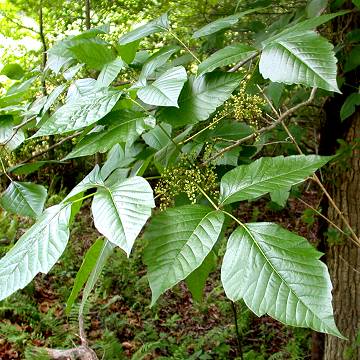

Toxicodendron radicans - (image 1 of 8)
Taxonomy
Family: Anacardiaceae
Plants in the genus Toxicodendron Mill. have in the past been included in the genus Rhus L. Plants in the genus Toxicodendron have a large number of resin ducts, flowers in loose, axillary, racemose inflorescences, and rather smooth white fruits. Plants in the genus Rhus have flowers in dense, terminal or lateral inflorescences and hairy reddish fruit.
Plants with puberulent, scabrous or pappilose fruit, glabrous or pubescent petioles, and entire leaflets with tufts of hairs in the vein-axils of the lower leaf surfaces are var. radicans. This variety is commoner on the coastal plain or east of the Appalachian divide.
Specimens with mostly glabrous fruits, pubescent petioles, and toothed leaflets with no hairs of hairs confined to the main veins of the lower leaf surfaces would be considered var. negundo (Greene) Reveal. This variety is found mostly west of the Appalachian divide and is the one found in the Chicago area.
Habitat
Open woodlands, wooded floodplains, dune slopes, sandy oak savanna. Fire adapted.
Associates
Not an indicator or uniquely associated with a particular community type
Distribution
Southern Nova Scotia south to FL, west to MI, southeast MN, eastern NE, OK, and TX, and south to Guatemala. Also occurs in China and Japan.
Morphology
Deciduous vine with abundant aerial roots to 45 m, spreading by underground stems or rhizomes; can also occur as a shrub to 2 m. Leaves emerging shiny, reddish to light green, becoming dull green, alternate, trifoliate; leaflets mostly flat, 5-15 cm, ovate to elliptic, acute or acuminate, entire or with a few irregular, more or less pointed teeth or shallow lobes, subsessile or with short petiolules, the terminal leaflet long-petiolulate. Dioecious; flowers small and green, less than 3 mm, in loosely branches axillary panicles to 10 cm; fruit a smooth, dry, round, ivory to gray drupe, 3-5 mm thick, persisting into the winter; an oily covering on the seed coat make the seeds buoyant, allowing them to be dispersed by water; also dispersed via ingestion by birds and mammals.
Notes
Flowers late May to late June
Wetland indicator: Facultative +
Poison Ivy is known for the allergic reaction caused by the organic oil
Urushiol, which induces an immune response by the body. Other plants in the
family Anacardiaceae can produce Urushiol, including Poison Sumac, Mango (mostly
in the skin of the fruit) and Cashew (in the shell of the nut). Not all
individuals are allergic. The leaves are eaten by white tailed deer and the
fruit is an important food source for a wide variety of
migrant and upland non game and game birds in fall and winter. Fall color can
range from bright yellow-orange to red.
References
Gleason, Henry A. and A. Cronquist. 1991. Manual of Vascular Plants of Northeastern United States and Adjacent Canada. Second Ed.
The New York Botanical Garden. Bronx, NY
Swink, F. and G. Wilhelm. 1994. Plants of the Chicago Region.
Indiana Academy of Science. The Morton Arboretum. Lisle, Illinois.
|
Michael Hough © 2005 |